![]()
![]()
![]()
Use LEFT and RIGHT arrow keys to navigate between flashcards;
Use UP and DOWN arrow keys to flip the card;
H to show hint;
A reads text to speech;
85 Cards in this Set
- Front
- Back

|
"D" Sampler |
|
|
Employed to collect large, semi-fragile zoo plankton. It is the only suitable tool for collecting the most fragile specimens without damage and was originally designed to collect marine "snow" and other detritus. |
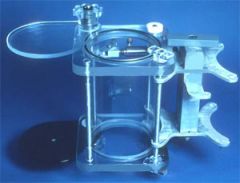
"D" Sampler |
|
|
one of the tools employed to collect large, semi-fragile zooplankton from an ROV or manned submersible. The system is, in effect, an underwater vacuum that collects animals under gentle suction and deposits them into a 6-liter (1.5 gallon) canister. |
The suction sampler or “critter getter” |
|
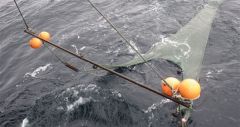
|
Trawls |
|
|
Nets towed behind a boat to collect organisms, have been used by fishers for centuries. |
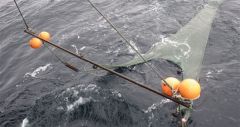
Trawls. They can be divided into three categories based on where they sample the water column: surface, midwater, and bottom. They may be divided further by their design and the materials used in their construction. The type of trawl used by researchers is determined by the type of organisms they are collecting and/or which part of the water column they are interested in sampling. |
|
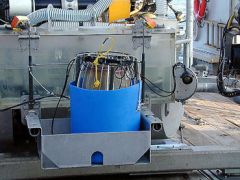
|
The "Bushmaster" and "Chimneymaster" are original instruments created by Charles Fisher's team at Penn State to collect communities on and around hydro thermal vents. The Bushmaster and Chimneymaster are large collection nets that can be closed by the submarine using a system of hydraulic cylinders and cables. They collect intact communities of tube worms and all associated fauna, either on the seafloor (using the Bushmaster) or on a sulfide chimney (using the Chimneymaster). On board the ship, and back in the laboratory, every single animal collected with these nets is identified and counted, and a variety of other measurements made on most of them. Because these collection devices are so efficient (catching almost everything larger than about 64 micrometers or 0.0026 inches) discoveries of new species in the collections are often made. |
|

|
Clod Cards. Clod cards are therefore an economical means of characterizing the near-bottom flow patterns in little-known ocean environments. |
|
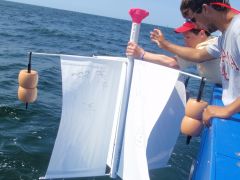
|
Drifters. Using devices known as drifters, scientists are beginning to grasp the complexities of global ocean currents, and, in turn, the many systems that they influence. With advances in technology, drifters now provide researchers with information about ocean circulation patterns in real time. The data garnered from these devices will allow scientists to design models of climate and weather patterns, such as El Niño and hurricanes, as well as predict where pollutants, such as oil or sewage, will go if they are dumped or accidentally spilled into the ocean. Information from drifters can also be used to learn more about the distribution and abundance of marine life with early life stages that are planktonic. Plankton are freely floating organisms that travel with oceanic currents. |
|
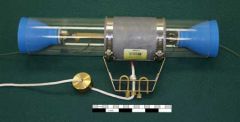
|
Van Dorn Bottle Samples water at any depth on a cable or line with a messenger
|
|

|
Nansen Bottle Samples:Water Operates:At any depth on a cable or line with a messenger that makes bottle rotate 180 degrees while trapping water and closing. Racks on side for reversing thermometers that record temperature of water when rotated 180 degrees (thus, when bottle rotates, temperature at that depth is recorded) |
|
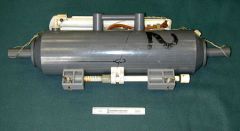
|
Niskin Bottle Samples:Water Operates:At any depth on a cable or line with a messenger |
|
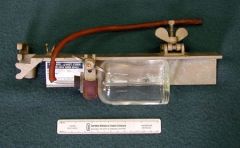
|
JZ Bacterialogical Bottle Samples: Water Operates: At any depth on a cable or line with a messenger Notes: Water is sampled in a sterile container for bacterial examination |
|
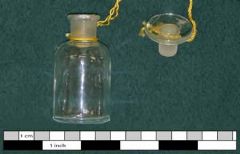
|
Surface Sample Bottle Samples:Water Operates:At the surface by hand or at any depth visited by a scuba diver Notes:Any type of bottle can be used to capture surface water |
|
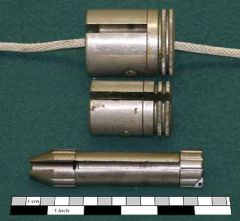
|
Messengers Used:To 'trigger' many types of samplers at a particular depth Operated:On a cable or line Notes:Twist the messenger to feel how easily it is attached to a cable or line |
|
|
Used:To 'trigger' many types of samplers at a particular depth Operated:On a cable or line Notes:Twist the messenger to feel how easily it is attached to a cable or line |
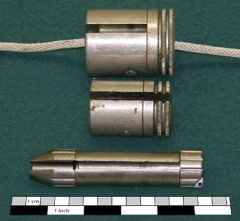
Messengers
|
|
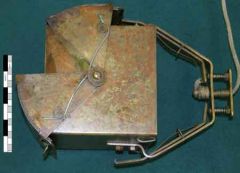
|
Ekman Grab Samples:Bottom sediments (mud or sand) Operates:In relatively shallow water on a cable or line triggered with a messenger Notes:Is made of brass and will bend if used to sample a rocky bottom |
|
|
Samples:Bottom sediments (mud or sand) Operates:In relatively shallow water on a cable or line triggered with a messenger Notes:Is made of brass and will bend if used to sample a rocky bottom |
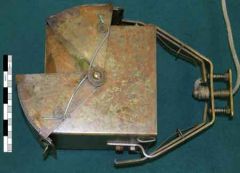
Ekman Grab
|
|
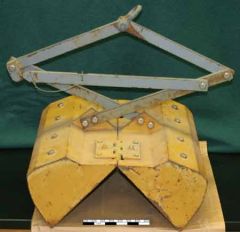
|
Petersen Grab Samples:Rocky bottoms Operates:At any depth on a cable or line by free fall (no messenger needed) Notes:Extremely heavy and can take a sample of the hardest rocky ocean bottoms (like granite and marble) |
|
|
Samples:Rocky bottoms Operates:At any depth on a cable or line by free fall (no messenger needed) Notes:Extremely heavy and can take a sample of the hardest rocky ocean bottoms (like granite and marble) |
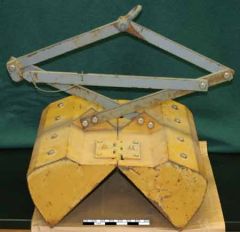
Petersen Grab
|
|
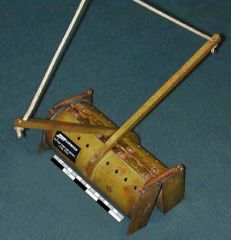
|
Soft Bottom Modified Petersen Grab Samples:Bottom sediments (mud or sand) Operates:At any depth on a cable or line by free fall (no messenger needed) Notes:May need a few tugs to get a sample in water less than 20 feet deep
|
|

|
Wash Bucket Used:To wash bottom sediments free of material less than 1/2 mm Operates:At the surface by hand Notes:Samples from the Ekman Grab and Soft Bottom Modified Petersen Grab are often processed with this in studies looking for organisms living in the sediments, the wash bucket gets rid of most of the sediments and all that is left are the critters (worms, snails, clams and small crustaceans) that live in the mud or sand
|
|
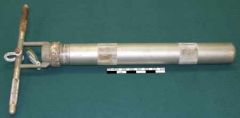
|
Bottom Corer Samples:Bottom sediments without disturbing the layering Operates:On a cable or line (free fall) or by hand without a messenger Notes:Bottom cores over 100 feet long are taken during oil exploration |
|
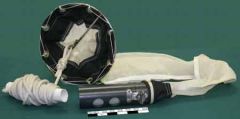
|
Standard Plankton Net Samples:Plankton Operates:On a cable or line by hand or behind a boat. Notes:Can be towed vertically or horizontally, some have meters that record the volume of water passing through the net, others have a device to keep the mouth of the net closed until it reaches a certain depth and then to close it after the tow |
|
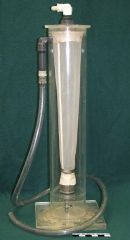
|
Deck Plankton Collector Samples:Plankton Operates:On the deck of a boat or float with a pump that pumps water from a particular depth through the net letting the overflow return to the ocean Notes:Generally a slow process and not as efficient as the Standard Plankton Net however it is good when plankton from a particular depth is needed as the pump can be turned on only when at a certain depth |
|

|
Folsom Plankton Splitter Samples:To split plankton samples equally so that the material in the sample near the surface and near the bottom is equally split Operates:By rotating a plankton sample in the enclosed drum Notes:Can be used again and again to get smaller and smaller subsamples |
|

|
Sedgewick-Rafter Plankton Counting Chamber Used:To view 1 ml plankton of a plankton sample Operates:Under the microscope Notes:By counting and recording only 1 ml of a large plankton sample it is possible to estimate the numbers of plankters in the entire sample in a short period of time |
|
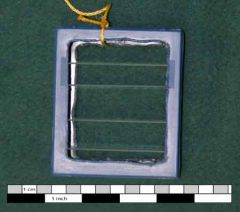
|
Succession Plates Samples:Fouling organisms in the ocean Operates:By placing these (or any solid material) in the ocean for a period of time Notes:Plates can be withdrawn periodically to determine the "succession" or organisms that settle and grow there |
|
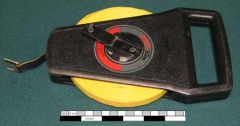
|
Transects Used:To describe (usually by counting and recording rather than taking) organisms in an environment in reference to a line (rope or tape measure) Operates:In any environment by hand |
|

|
Quadrats Used:To describe (usually by counting and recording rather than taking) organisms in an environment found within the perimeter of a certain sized material Operates:In any environment by hand
|
|
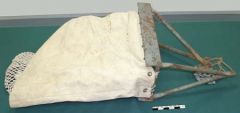
|
Biological Dredge Samples:Organisms living on a rocky bottom Operates:At any depth on a cable or line (generally with a hydraulic winch) Notes:Often rips specimens off and can be destructive |
|

|
Beach Seine Samples:Organisms living on a sandy bottom near shore Operates:From the shore to about 15 feet of water by hand (many people) Notes:Outlawed for most uses, a special State permit is hard to get |
|
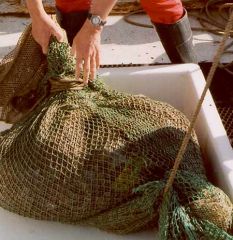
|
Otter Trawl Samples:Organisms on or near (within a few feet) sandy or muddy bottoms Operates:At any depth by cable or line by hand or hydraulic winch Notes:Used by fishermen for flatfish (sole, halibut, flounder) and shrimp |
|

|
Isaacs-Kidd Midwater Trawl Samples:Organisms in the water column Operates:At any depth (not on the bottom) on a cable or line by hydraulic winch Notes:This is a model of the net, most are at least 10-15 feet square at the mouth |
|

|
Standard Thermometer Measures:Temperature in degrees Operates:At the surface by hand or line Notes:An easy way to get a quick surface sea temperature from a big vessel when you are unable to reach the water |
|
|
Measures:Temperature in degrees Operates:At the surface by hand or line Notes:An easy way to get a quick surface sea temperature from a big vessel when you are unable to reach the water |

Standard Thermometer |
|

|
Bucket Thermometer Measures:Temperature in degrees Operates:At the surface by hand or line Notes:An easy way to get a quick surface sea temperature from a big vessel when you are unable to reach the water |
|
|
Measures:Temperature in degrees Operates:At the surface by hand or line Notes:An easy way to get a quick surface sea temperature from a big vessel when you are unable to reach the water |

Bucket Thermometer
|
|

|
Reversing Thermometer (for Nansen Bottle) Measures:Temperature in degrees Operates:Only when turned 180 degrees (the mercury breaks in the special loop and will not get back together until reset thus, temperature at depth can be recorded with a 180 degree flip (as is done with the Nansen Bottle) and there will be no change on the way up. |
|
|
Measures:Temperature in degrees Operates:Only when turned 180 degrees (the mercury breaks in the special loop and will not get back together until reset thus, temperature at depth can be recorded with a 180 degree flip (as is done with the Nansen Bottle) and there will be no change on the way up. |

Reversing Thermometer (for Nansen Bottle)
|
|

|
Bathythermograph (BT) Measures:Water Operates:Over any depth with a cable or line by hand or with a hydraulic winch Notes:This model records the information inside and is retrieved however there are expendable models (XBTs) that free fall on a copper line and transmit the temperature and depth information through the copper wire before dropping to the bottom |
|
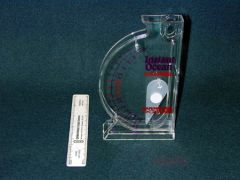
|
Hydrometer (quick test type for aquariums) Measures:Salinity in parts per thousand (o/oo) Operates:By reading the density (specific gravity) of the water that corresponds to salinity. Increasing dissolved salts increase the density. |
|
|
Measures:Salinity in parts per thousand (o/oo) Operates:By reading the density (specific gravity) of the water that corresponds to salinity. Increasing dissolved salts increase the density. |
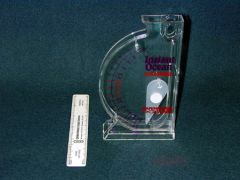
Hydrometer (quick test type for aquariums)
|
|

|
Hydrometer Set (cylinder, hydrometer, thermometer, TSD graph) Measures:Salinity in parts per thousand (o/oo) Operates:With a water sample by using a hydrometer to measure the density of the water (water with more salt is more dense and will float the hydrometer higher in the cylinder) which can then be used along with the temperature in a standard TSD graph (temperature, salinity, density) to find the salinity since these three variables have a known relationship |
|
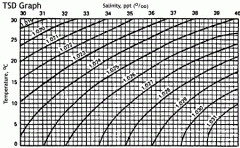
|
TSD Graph |
|

|
Chemical Test Kit (Knudsen Titration modification) for Salinity Measures:Salinity in parts per thousand (o/oo) Operates:By a chemical titration with a water sample to determine just one of the salts (chloride ion) and extrapolate the rest of the salinity Notes:Not very accurate because of interaction of other salts
|
|
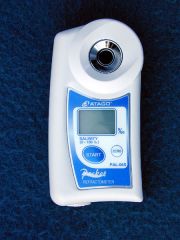
|
Salinometer Measures:Salinity in parts per thousand (o/oo)Operates:By measuring the electrical conductivity and extrapolating
|
|

|
Chemical Test Kit (Winkler Titration) for Oxygen Measures:Oxygen in parts per million (ppm)Operates:By chemical titration with a water sample to determine the amount of dissolved oxygen (DO), not the bubblesNotes:Very accurate |
|
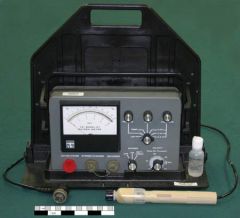
|
Dissolved Oxygen Probe Measures:Oxygen in parts per million (ppm)Operates:ElectronicallyNotes:Very accurate |
|

|
pH test strips Measures:pH (in numbers) Operates:By a color comparator Notes:This set is specific for the 7.5 to 8.5 range of seawater.
|
|
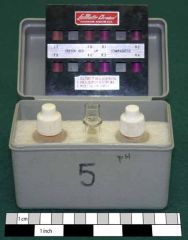
|
Chemical Test Kit for Saltwater pH Measures:pH (in numbers) Operates:By a color indicator Notes:Sometimes hard to make a color choice |
|

|
pH meter Measures:pH Operates:Electronically Notes:Fast and easy way to record pH |
|

|
Secchi Disk Measures:Visibility (vertical) Operates:By hand on a line to the depth where it becomes invisible Notes:May be hard for the viewer to be exact but a good approximation
|
|
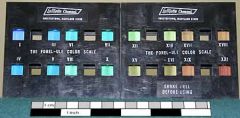
|
Forel/Ule Scale Measures:Color of the water (in roman numerals associated with colors from brown to green to blue) Operates:As a color comparator with the use of the secchi disk lowered to one meter for background so the color of the bottom won't interfere |
|
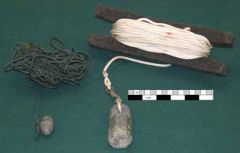
|
Sounder (lead line) Measures:Depth (in meters or feet) Operates:At any depth on a cable or line generally by hand Notes:Until 1993 most of the hydrographic (ocean bottom) maps from Santa Barbara Harbor north for many miles were done with a hand held sounder |
|

|
Fathometer Measures:Depth (in meters or feet) Operates:Electronically by sending a sound from the boat and receiving the sound waves that bounce back from the bottom, the depth is read from a paper chart moving through the fathometer calibrated to record the depth
|
|
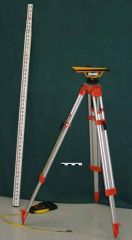
|
Surveying Equipment (Sighting level, Tripod, Stadia Rod) Measures:Profile of the beach and shallow (to a few feet) wave wash area Operates:By sighting through the sighting level (stabilized and leveled on the tripod) to stadia rods (marked in feet) held on the beach |
|
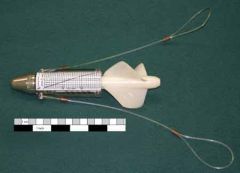
|
Current Meters Measures:Relative speed of water flow (current) Operates:At any depth by cable or line Notes:Other current meters are on top of the cupboards in lab, some have directional recorders as well |
|
|
Measures:Relative speed of water flow (current) Operates:At any depth by cable or line Notes:Other current meters are on top of the cupboards in lab, some have directional recorders as well |

Current Meters |
|
|
To stain the water so that its movement (current) can be tracedOperates:By pouringNotes:Nontoxic and biodegradable (is gone in about 20 minutes) |

Dye for Currents |
|

|
surface drogue (with float) Measures:Currents over long distances Operates:By releasing many and hoping for recapture (only a few percent are ever recaptured)
|
|

|
bottom drogue (with weight) Measures:Currents over long distances Operates:By releasing many and hoping for recapture (only a few percent are ever recaptured) |
|
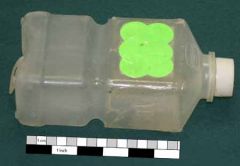
|
Drift Bottles Measures:Currents Operates:By releasing a few Notes:May be affected by the wind but a quick and easy way to measure a current. |
|
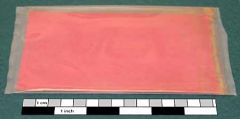
|
Drift Cards Measures:Currents Operates:By releasing Notes:Weighted to stay just below the surface of the water.
|
|
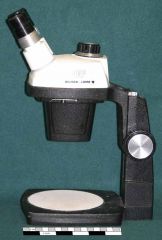
|
Dissecting Microscope Magnification is changed by moving the wheel at the top. |
|
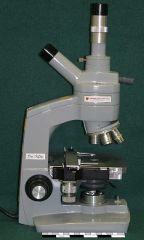
|
Compound Microscope The eyepieces magnify 10 times and the objective lenses (near the specimen) can be changed. Total magnification is a combination of the eyepiece and the objective lens (multiplied). For example, the 10X objective lens and the 10X eyepieces combine for a total of 100X (100 times magnification). |
|

|
Electron Microscope The electron microscope brings minute detail out in marine specimens that are very small. This electron microscope is a small tabletop model that is computer controlled. It is located at UCSB. James Weaver (seen in the image), a UCSB graduate student, is a former SBCC student from the Biological Sciences Department. He graduated from UCSB already and is currently doing graduate research for his doctorate degree on the formation of silica spicules in marine sponges and other materials. He uses this electron microscope for his research. The image shows a diatom displayed on the computer screen. |
|
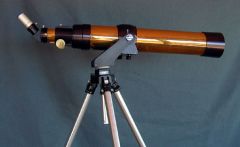
|
Telescope allow marine scientists to view things from afar. |
|
|
allow marine scientists to view things from afar. |
Telescope |
|
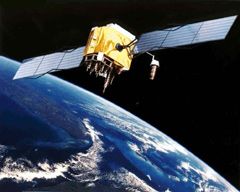
|
Satellite can be used by marine scientists in various ways. Many satellites send images back to Earth that show the surface of the ocean and its color, temperature, and exaggerated level thus acting as a remote sensor. Satellites are also used by marine scientists to bounce information off of (for example a radio tag on an elephant seal can broadcast data about the seal's activities to the satellite and it is bounced back to the researcher). |
|
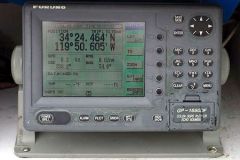
|
GPS GPS units allow marine scientists to be very accurate with locating their study areas. The longitude and latitude of geographic locations can be measured so that scientists can return to the exact same location. This was very difficult for marine scientists before GPS units because there are few reference points on the ocean. If locations were near the shore scientists could take 'line ups' of visual markers on shore but if locations were far from shore, or if it was foggy, these would not work. Thus, GPS units act like a special type of 'seeing' device for global positioning. |
|

|
Compass A compass is an integral part of a GPS unit but can also be used by itself for taking any type of directional measurement. |
|
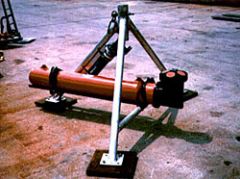
|
Acoustic Doppler Current Profiler (ADCP) An Acoustic Doppler Current Profiler, or Acoustic Doppler Profiler, is often referred to with the acronym ADCP. Scientists use the instrument to measure how fast water is moving across an entire water column |
|
|
Often referred to with the acronym ADCP. Scientists use the instrument to measure how fast water is moving across an entire water column |
Acoustic Doppler Current Profiler (ADCP) |
|

|
Acoustic Recording Packages (ARPs) are long-term, autonomous devices which record marine mammal calls. |
|
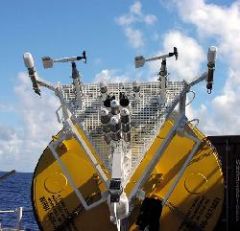
|
Air-Sea Interaction Meteorology: The ASIMET System The ASIMET system is a set of seven very precise sensors that measure how energy and water move between the ocean and atmosphere. Those measurements are the raw materials for many calculations about climatic conditions.
|
|
|
is a set of seven very precise sensors that measure how energy and water move between the ocean and atmosphere. Those measurements are the raw materials for many calculations about climatic conditions. |
Air-Sea Interaction Meteorology: The ASIMET System |
|
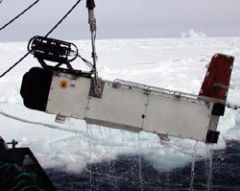
|
BIOMAPER-II The BIo-Optical Multi-frequency Acoustical and Physical Environmental Recorder
|
|

|
Bongo Paired Zooplankton Net |
|

|
Box Corer This is one of the simplest and most commonly used sediment corers. The stainless steel sampling box can contain a surface sediment block as large as 50cm X 50cm X 75cm with negligible disturbance. Once the sediment is recovered onboard, the sediment box can be detached from the frame and taken to a laboratory for subsampling and further analysis. |
|
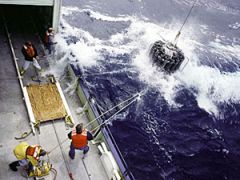
|
A CTD — an acronym for Conductivity, Temperature, and Depth — is the primary tool for determining essential physical properties of sea water. It gives scientists a precise and comprehensive charting of the distribution and variation of water temperature, salinity, and density that helps to understand how the oceans affect life. |
|
|
is the primary tool for determining essential physical properties of sea water. It gives scientists a precise and comprehensive charting of the distribution and variation of water temperature, salinity, and density that helps to understand how the oceans affect life. |
A CTD — an acronym for Conductivity, Temperature, and Depth |
|

|
Grab Sampler This sediment sampler has a clam shell-type scoop setup |
|

|
Gravity Corer The gravity corer allows researchers to sample and study sediment layers at the bottom of lakes or oceans. It got its name because gravity carries it to the bottom of the water body. |
|

|
Acoustic Doppler Current Profiler The Acoustic Doppler Current Profiler (ADCP) measures the speed and direction of ocean currents using the principle of “Doppler shift”. Anyone who has ever heard a train whistle is familiar with the Doppler effect. |
|
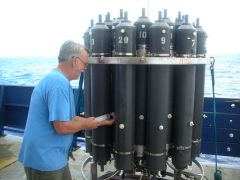
|
Sonde and CTD One type of instrument package, sometimes called sondes, are ideal for profiling and monitoring water conditions in industrial and wastewater effluents, lakes, rivers, wetlands, estuaries, coastal waters, and the open ocean. Torpedo-shaped in appearance, sondes may have multiple sensors that record a range of water quality data. If the sonde has “on board” battery power, it can be left unattended for weeks at a time, with measurement parameters sampled at preprogramed intervals and data securely saved in the unit's internal memory. |

